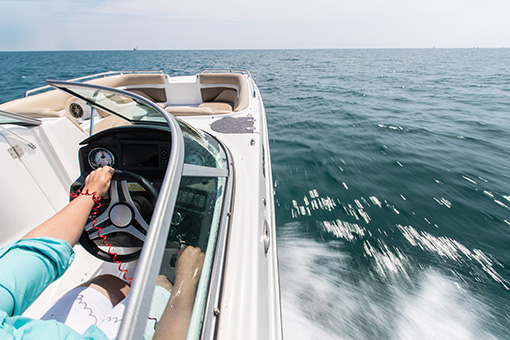It may not be the flashiest piece of boating gear, but few items are more important than your boat owner’s manual. Simply put, it contains everything you need to know to enjoy safe, and hassle-free time on the water.
What Is a Boat Owner’s Manual?

Your boat owner’s manual is a go-to guide that covers pretty much everything you need to know about your vessel. While content varies slightly by make and model, here’s a general overview of what you can expect to find:
Section 1: The Introduction
The opening pages generally offer a warm introduction to your boat—highlighting its key features and intended uses.
- Model Information. It’ll list your specific boat model, year, and hull identification number (HIN)—handy info should you ever need to reference it.
- Important Safety Information. There’s usually a section dedicated to general boat safety guidelines.
- Warranty Information. Expect to find a summary overview your boat's warranty coverage, listing what's included and how to register it.
Section 2: Your Boat’s Anatomy
This section overviews the physical components of your boat—offering a thorough walk-through of its layout and functionality.
- Deck Layout and Features. Learn the location and function of cleats, rails, storage compartments, and other deck hardware.
- Hull Design and Construction. Find a brief overview of your boat’s construction—including the build materials and any unique characteristics.
Section 3: Engine and Propulsion
For most boaters, the engine is the heart of their vessel. That’s why your boat owner’s manual will generally cover it in detail.
- Engine Specifications. Includes your engine’s make, model, horsepower, and fuel requirements.
- Starting and Stopping Procedures. Expect to find step-by-step instructions for safely starting and shutting down your engine.
- Maintenance Schedule. A list of routine maintenance tasks—oil changes, filter replacements, spark plug checks, etc.
- Troubleshooting Guide. Personally? This section is one of our favorites. It explains common engine problems and suggests solutions—a lifesaver when you’re out on the water without service!
Section 4: Controls and Instrumentation
Next up, your helm station. Your boat owner’s manual will help you make sense of all those gauges and switches.
- Helm Controls. Covers everything you need to know about the throttle, shift lever, steering system, and trim/tilt controls.
- Instrumentation. Explains what each gauge signifies (RPMs, fuel level, oil pressure, battery voltage, etc.) and what normal readings should look like.
- Electrical System Basics. Includes information on the battery switch, fuses, circuit breakers, etc.
- Navigation Lights. Provides guidance on how to correctly use your boat’s navigation lights.
Section 5: Safety Equipment and Procedures
Arguably the most important section in your manual—make sure you familiarize yourself with it.
- Required Safety Equipment. A list of all the necessary safety gear including life jackets, fire extinguishers, sound-producing devices, visual distress signals, etc.
- Emergency Procedures. Outlines what to do in the event of an emergency (engine failure, fire, man overboard, grounding, etc.)—which, as you can guess, is incredibly important.
- Carbon Monoxide Safety. If your boat has a cabin, you will likely find a section on how to prevent carbon monoxide poisoning.
- Fueling Procedures. Find info covering safe fueling practices.
Section 6: Systems and Comforts
Your manual will also explain all the systems that make boating comfortable.
- Freshwater System. Details the operation of sinks, showers, and freshwater tanks.
- Wastewater System. Learn about the proper use and maintenance of marine heads (toilets) and holding tanks.
- Bilge Pumps. Covers how to operate your bilge pumps (and troubleshoot problems).
- Heating and Cooling Systems. If your boat has AC or heating, you’ll find that info here.
- Anchor System. Includes proper anchoring techniques, as well as maintenance guidelines.
Section 7: Maintenance and Storage
Last but certainly not least, your boat owner’s manual will include a section on maintenance and storage—which are key to keeping your boat looking great and functioning at its best!
- Cleaning and Detailing. Features proper cleaning and maintenance techniques.
- Winterization and De-winterization. Step-by-step guidelines for preparing your boat for off-season storage and getting it ready for spring launch.
- Trailer Operation and Maintenance. If your boat is trailered, you’ll find information on towing, launching, retrieving, and trailer maintenance.
How to Use a Boat Owner’s Manual
As we mentioned, your boat owner’s manual is not just for reference—it’s an invaluable safety tool and a fantastic resource while out on the water. Here are just a few reasons why every boater should familiarize themselves with it.
- Safety First. Your manual will tell you exactly what to do in the event of an emergency.
- Troubleshooting Made Easy. Instead of guessing or panicking, your manual will offer step-by-step instructions for diagnosing and resolving common issues.
- Protect Your Investment. Your boat owner’s manual has maintenance guidelines that will protect your investment and keep your boat running in tip-top shape.
So, if you haven’t reviewed your boat owner’s manual, here is your sign to do so. Read it, understand it, and keep it accessible. Personally? We keep ours in a waterproof bag on board. Just an idea!

